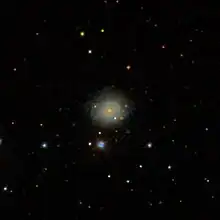NGC 226
NGC 226 is a spiral galaxy located approximately 216 million light-years from the Sun[2] in the constellation Andromeda. It was discovered on December 21, 1786, by William Herschel.[3]
| NGC 226 | |
|---|---|
 SDSS image of NGC 226 | |
| Observation data (J2000 epoch) | |
| Constellation | Andromeda |
| Right ascension | 00h 42m 54.0s[1] |
| Declination | +32° 34′ 51″[1] |
| Redshift | 0.016094[1] |
| Distance | 216 Mly[2] |
| Apparent magnitude (V) | 14.31[1] |
| Characteristics | |
| Type | S[1] |
| Apparent size (V) | 0.9' × 0.9'[1] |
| Other designations | |
| UGC 00459, CGCG 500-076, 2MASX J00425403+3234516, 2MASXi J0042540+323451, IRAS 00402+3218, F00401+3218, PGC 2572.[1] | |
References
- "NASA/IPAC Extragalactic Database". Results for NGC 0226. Retrieved 2016-09-02.
- An object's distance from Earth can be determined using Hubble's law: v=Ho is Hubble's constant (70±5 (km/s)/Mpc). The relative uncertainty Δd/d divided by the distance is equal to the sum of the relative uncertainties of the velocity and v=Ho
- "New General Catalog Objects: NGC 200 - 249". Cseligman. Retrieved September 10, 2016.
External links
 Media related to NGC 226 at Wikimedia Commons
Media related to NGC 226 at Wikimedia Commons- NGC 226 on WikiSky: DSS2, SDSS, GALEX, IRAS, Hydrogen α, X-Ray, Astrophoto, Sky Map, Articles and images
- SEDS
This article is issued from Wikipedia. The text is licensed under Creative Commons - Attribution - Sharealike. Additional terms may apply for the media files.